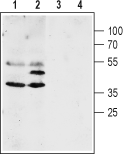Overview
- Peptide (C)HVIDIDRGDEKKGKD, corresponding to amino acid residues 300-314 of rat AQP4 (Accession P47863). Intracellular, C-terminus.

 Western blot analysis of mouse (lanes 1 and 3) and rat (lanes 2 and 4) brain lysates:1,2. Anti-Aquaporin 4 (AQP4) (300-314) Antibody (#AQP-014), (1:200).
Western blot analysis of mouse (lanes 1 and 3) and rat (lanes 2 and 4) brain lysates:1,2. Anti-Aquaporin 4 (AQP4) (300-314) Antibody (#AQP-014), (1:200).
3,4. Anti-Aquaporin 4 (AQP4) (300-314) Antibody, preincubated with Aquaporin 4/AQP4 (300-314) Blocking Peptide (#BLP-QP014).
 Expression of Aquaporin 4 in rat brainImmunohistochemical staining of rat brain using Anti-Aquaporin 4 (AQP4) (300-314) Antibody (#AQP-014), (1:200). A. Aquaporin 4 (green) is detected in blood vessels in layers 1-3 of rat neocortex. B. Astrocytic processes were stained using mouse anti glial fibrillary acidic protein (GFAP) (red) and DAPI (blue) was used to delineate the cortical layers. C. Merge of Aquaporin 4 and GFAP shows overlap along blood vessels (arrows) in agreement with the role of astrocytes and Aquaporin 4 in regulation of the blood-brain barrier.
Expression of Aquaporin 4 in rat brainImmunohistochemical staining of rat brain using Anti-Aquaporin 4 (AQP4) (300-314) Antibody (#AQP-014), (1:200). A. Aquaporin 4 (green) is detected in blood vessels in layers 1-3 of rat neocortex. B. Astrocytic processes were stained using mouse anti glial fibrillary acidic protein (GFAP) (red) and DAPI (blue) was used to delineate the cortical layers. C. Merge of Aquaporin 4 and GFAP shows overlap along blood vessels (arrows) in agreement with the role of astrocytes and Aquaporin 4 in regulation of the blood-brain barrier.
 Expression of Aquaporin 4 in rat glioma C6 cellsImmunocytochemical staining of fixed and permeabilized rat glioma C6 cells. A. Cells were stained with Anti-Aquaporin 4 (AQP4) (300-314) Antibody (#AQP-014), (1:200), followed by goat anti-rabbit-AlexaFluor-594 secondary antibody (red). B. Cell nuclei were visualized using Hoechst 33342 (blue). C. Merge of the two images.
Expression of Aquaporin 4 in rat glioma C6 cellsImmunocytochemical staining of fixed and permeabilized rat glioma C6 cells. A. Cells were stained with Anti-Aquaporin 4 (AQP4) (300-314) Antibody (#AQP-014), (1:200), followed by goat anti-rabbit-AlexaFluor-594 secondary antibody (red). B. Cell nuclei were visualized using Hoechst 33342 (blue). C. Merge of the two images.
- King, L.S. et al. (2004) Nat. Rev. Mol. Cell Biol. 5, 687.
- Manley, G.T. et al. (2004) Neuroscience. 129, 983.
- Lennon, V.A. et al. (2005) J. Exp. Med. 202, 473.
Aquaporin 4 (AQP-4) belongs to a family of membrane proteins that allow passage of water and certain solutes through biological membranes. The family is composed of 13 members (AQP-0 to AQP-12).
The aquaporins can be divided into two functional groups based on their permeability characteristics: the aquaporins that are only permeated by water and the aquaglyceroporins that are permeated by water and other small solutes such as glycerol. AQP-4 together with AQP-1, AQP-2 and AQP-5 belong to the first group1. Little is known about the function of the two newest members, AQP-11 and AQP-12.
The proteins present a conserved structure of six transmembrane domains with intracellular N- and C-termini. The functional channel is a tetramer but each subunit has a separate pore and therefore the functional channel unit, contains four pores1.
AQP-4 is the major membrane water channel in the central nervous system. The channel is expressed in astrocyte foot processes in direct contact with capillary vessels in the brain suggesting a role in water transport under normal and pathological conditions. Indeed, transgenic mice lacking AQP-4 have reduced brain swelling and improved neurological outcome following water intoxication and focal cerebral ischemia. In contrast, brain swelling and clinical outcome are worse in AQP-4-null mice in models of vasogenic (fluid leak) edema caused by freeze-injury and brain tumor, probably due to impaired AQP-4-dependent brain water clearance2.
In addition, it has been recently shown that neuromyelitis optica (NMO), an inflammatory demyelinating disease that selectively affects optic nerves and spinal cord, is caused by the development of an autoantibody directed against AQP-43.
Application key:
Species reactivity key:
Anti-Aquaporin 4 (AQP4) (300-314) Antibody (#AQP-014) is a highly specific antibody directed against an epitope of rat AQP4. The antibody can be used in western blot, immunohistochemistry, and immunocytochemistry applications. It has been designed to recognize the Aquaporin 4 channel from rat, mouse, and human samples.
Applications
Citations
- Mouse spinal cord sections.
Dai, J. et al. (2017) Mol. Med. Rep. 16, 1739.
